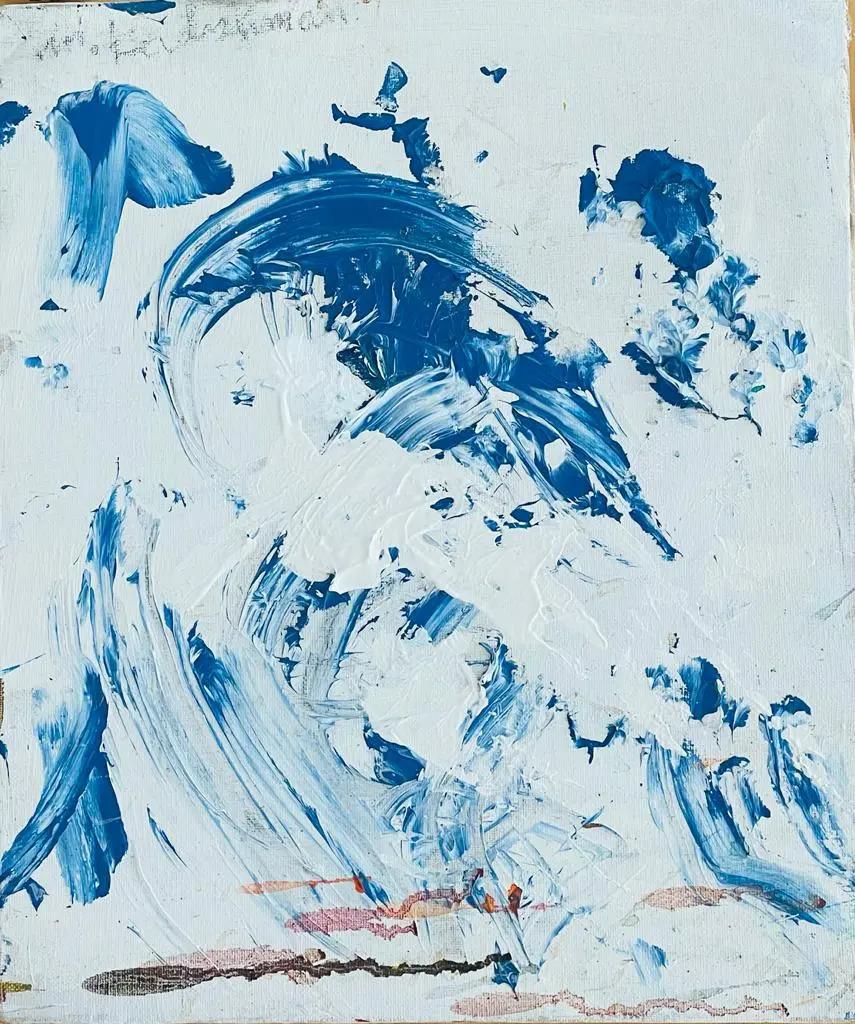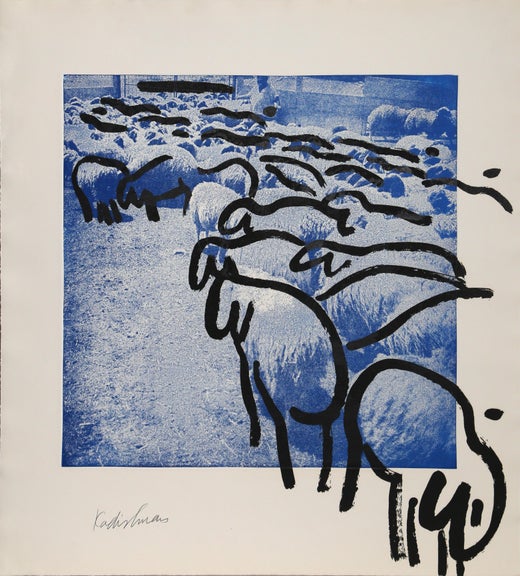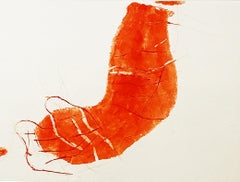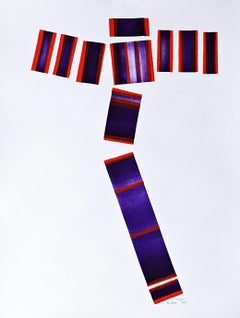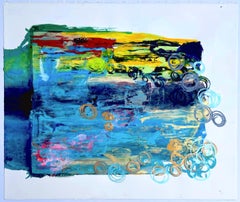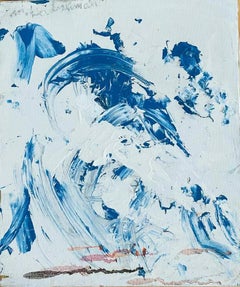Items Similar to Clothes 2
Want more images or videos?
Request additional images or videos from the seller
1 of 12
Menashe KadishmanClothes 21973
1973
$500
£382.31
€437.94
CA$705.20
A$767.53
CHF 410.14
MX$9,268.84
NOK 5,154.47
SEK 4,794.26
DKK 3,271.60
About the Item
Menashe Kadishman
Clothes 2, 1973
Silkscreen on wove paper
Signed and numbered 31/70 on the front
23 1/4 × 32 1/2 inches
Edition 31/70
Chris Prater of Kelpra Studio, Kentish Town, England
Unframed
Another example of Clothes 2 is in the permanent collection of the Tate Gallery - and the print looks just like clothes. Perfect for any laundry or children's room!
Signed, dated and numbered 31/70 in graphite on the front; bears legendary Kelpra Studio blindstamp on the back
- Creator:Menashe Kadishman (1932, Israeli)
- Creation Year:1973
- Dimensions:Height: 23.25 in (59.06 cm)Width: 32.5 in (82.55 cm)
- Medium:
- Movement & Style:
- Period:
- Condition:There is creasing especially around the margins, which should frame out (see photos) hence reduced price.
- Gallery Location:New York, NY
- Reference Number:1stDibs: LU1745211492312
Menashe Kadishman
Menashe Kadishman was born in Mandate Palestine. His father died when he was 15 years old. He left school to help his mother and provide for the family.[1] From 1947 to 1950, Kadishman studied with the Israeli sculptor Moshe Sternschuss at the Avni Institute of Art and Design in Tel Aviv, and in 1954 with the Israeli sculptor Rudi Lehmann in Jerusalem. In 1950–1953, Kadishman worked as a shepherd on Kibbutz Ma'ayan Baruch. This experience with nature, sheep and shepherding had a significant impact on his later artistic work and career. In 1959, Kadishman moved to London to study at Saint Martin's School of Art and the Slade School of Art.[2] In 1959-1960 he also studied with Anthony Caro and Reg Butler.[2] He had his first one-man show there in 1965 at the Grosvenor Gallery. In 1972, he returned to Israel. In the 1960s, Kadishman's sculptures were Minimalist in style, and so designed as to appear to defy gravity. This was achieved either through careful balance and construction, as in Suspense (1966), or by using glass and metal so that the metal appeared unsupported, as in Segments (1968). The glass allowed the environment to be part of the work. The first major appearance of sheep in his work was at the 1978 Venice Biennale, where Kadishman presented a flock of colored live sheep as living art.[4] In 1995, he began painting portraits of sheep by the hundreds, and even thousands, each one different from the next. These instantly-recognizable sheep portraits soon became his artistic "trademark"
About the Seller
5.0
Gold Seller
Premium sellers maintaining a 4.3+ rating and 24-hour response times
Established in 2007
1stDibs seller since 2022
468 sales on 1stDibs
Typical response time: 1 hour
- ShippingRetrieving quote...Shipping from: New York, NY
- Return Policy
More From This Seller
View AllFrench artist Pierre Tal-Coat, Untitled from the Swiss Society of Arts Portfolio
By Pierre Tal-Coat
Located in New York, NY
Pierre Tal-Coat
Untitled, from the Swiss Society of Arts Portfolio, 1975
Lithograph on paper with deckled edges. Hand Signed. Numbered. Unframed
Hand signed and numbered on the lower...
Category
1970s Abstract Abstract Prints
Materials
Lithograph
5745 Jewish Museum Hanukkah original Signed/n abstract expressionist screenprint
By Nancy Graves
Located in New York, NY
Nancy Graves
5745, for the Jewish Museum, 1984
Silkscreen on paper
Signed, numbered 5/90 and dated in graphite pencil on the front; bears publishers' blind stamp front left corner
3...
Category
1980s Abstract Expressionist Abstract Prints
Materials
Screen
Untitled Minimalist painting on paper Signed by pioneering sculptor Lyman Kipp
Located in New York, NY
Lyman Kipp
Untitled drawing, 1993
Unique Colored Ink Drawing on paper with two deckled edges
Hand signed, inscribed and dated by the artist on lower front
26 1/4 × 20 inches
Unframed...
Category
1990s Minimalist Abstract Drawings and Watercolors
Materials
Ink, Oil
$2,275 Sale Price
30% Off
Untitled Abstraction
Located in New York, NY
Leslie B. Weissman
Untitled abstraction, 2016
Acrylic and mixed media painting on paper
15 × 18 inches
Pencil signed and dated by the artist on the lower left front
Unframed
Biography:
Leslie B. Weissman (b. 1966, NYC)
Education:
Hobart and William Smith Colleges BA 1988 Art and Economics
New York University / Tisch MPS 1991
Recent and Upcoming Exhibitions:
PFLAG Pride In Bloom Exhibit and benefit Auction October 2020
Blue Door Gallery - Yonkers, NY Group Show, Global Expressions September 12, to October 24, 2020
Blue Door Gallery - Yonkers, NY Group Show, Summer Blues July 24, to August 29, 2020
Blue Door Gallery - Yonkers,, NY Group Show, Kinda Blue October-November 2018
Riverfront Art Gallery - Yonkers,, NY Group Show, Womantide March-April 2019
Blue Door Gallery - Yonkers,, NY Group Show, Kinda Blue October-November 2018
Morgan Stanley Corporate Headquarters - Purchase, NY September-October 2018
The Art Closet Gallery March 2018 Selected Works
Artist in Residence Chappaqua Performing Arts Center 2018 New Castle Board Inauguration conducted by President Bill Clinton
Katonah Museum AA at NWHC September 2017-March 2018
Left Fields Gallery SAN LUIS OBISPO, CA - 12/18-1/17/16 FORM IS NOT DIFFERENT FROM EMPTINESS -
Curated by Ryan Schneider...
Category
2010s Abstract Abstract Paintings
Materials
Mixed Media, Acrylic
Untitled, from the Long Point Gallery Portfolio
Located in New York, NY
Judith Rothschild
Untitled, from the Long Point Gallery Portfolio, 1988
Woodcut on paper
Hand signed, numbered 22/30 and dated on lower fr...
Category
1980s Abstract Abstract Prints
Materials
Pencil, Woodcut
Thou Shalt Not Make Graven Images (The Second Commandment), Lithograph Signed/N
Located in New York, NY
Joseph Nechvatal
Thou Shalt Not Make Graven Images (The Second Commandment), 1987
3 Color lithograph on Arches paper with deckled edges
Signed and numbered from the limited edition of 84 on the front
24 × 18 inches
Unframed
This three color lithograph on Arches paper with deckled edges is pencil signed, dated and numbered from the limited edition of 84. This classic Nechvatal print was created as part of the 1987 portfolio "The Ten Commandments", in which ten top Jewish American artists were each invited to choose an Old Testament commandment to interpret in contemporary lithographic form. The "Chosen" artists were, in order of Commandment: Kenny Scharf, Joseph Nechvatal, Gretchen Bender...
Category
1980s Abstract Abstract Prints
Materials
Lithograph
You May Also Like
Tree in Tree (Red and Orange), Conceptual Screenprint by Menashe Kadishman
By Menashe Kadishman
Located in Long Island City, NY
Artist: Menashe Kadishman, Israeli (1932 - 2015)
Title: Tree in Tree (Red and Orange)
Year: 1979
Medium: Screenprint, signed and numbered in pencil
Edition: 125
Size: 41 x 30...
Category
1970s Conceptual Abstract Prints
Materials
Screen
The Shepherd
By Menashe Kadishman
Located in Jerusalem, IL
A beautiful and unique large scale oil painting by Israeli artist Menashe Kadishman.
Featuring a figure of a shepherd and his flock of sheep.
Category
1980s Paintings
Materials
Canvas, Oil
Tree in Tree (Burgundy and Gold), Conceptual Screenprint by Menashe Kadishman
By Menashe Kadishman
Located in Long Island City, NY
Artist: Menashe Kadishman, Israeli (1932 - 2015)
Title: Tree in Tree (Burgundy and Gold)
Year: 1979
Medium: Screenprint, signed and numbered in pencil
Edition: 125
Size: 41 x...
Category
1970s Conceptual Abstract Prints
Materials
Screen
The Tide
By Menashe Kadishman
Located in Jerusalem, IL
Menashe Kadishman - The Tide - Kings Gallery - Fine art - Israeli art - Israeli artist - international art - Sheep.
“The Tide” by Menashe Kadishman
Menashe Kadishman721ViewsItamarIta...
Category
1980s Abstract Abstract Paintings
Materials
Canvas, Oil
Tree in Tree (Green and Purple), Conceptual Art Screenprint by Menashe Kadishman
By Menashe Kadishman
Located in Long Island City, NY
Artist: Menashe Kadishman, Israeli (1932 - 2015)
Title: Tree in Tree (Green and Purple)
Year: 1979
Medium: Screenprint, signed and numbered in pencil
Edition: 125
Size: 41 x ...
Category
1970s Conceptual Abstract Prints
Materials
Screen
Tree Abstract, Serigraph by Menashe Kadishman
By Menashe Kadishman
Located in Long Island City, NY
Artist: Menashe Kadishman, Israeli (1932 - 2015)
Title: Tree in Tree
Year: 1979
Medium: Serigraph, signed and numbered in pencil
Edition: 125
Size: 41 x 30 in. (104.14 x 76....
Category
1970s Conceptual Abstract Prints
Materials
Screen
